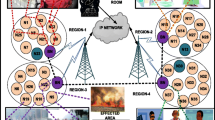Abstract
Wireless sensor networks (WSNs) enable a wide variety of applications resulting in still increasing requirements for the protocols supporting the operations. The medium access control (MAC) layer protocols are essential for improving the performance of an application and its quality of service because MAC protocols influence channel capacity utilization, network delay, energy consumption, and scalability. The contribution of this paper is two novel cluster-based time division multiple access (TDMA) scheduling MACs for WSNs and an analysis of the mobility impact on both. The proposed MAC layer protocols support real time applications where the cluster-based scheduling improves the scalability and also improves the performance in varying network conditions. The paper presents the design, implementation and performance evaluation of the proposed cluster based TDMA scheduling algorithms green conflict free (GCF) and multicolor-GCF (M-GCF) for high complexity and high requirement applications of WSNs under both low and high mobility conditions. The comparative evaluation shows that the M-GCF algorithm has better slot sharing and less conflicts with reduced communication energy consumption, delay, and good throughput under static and low mobility conditions while the GCF algorithm has better performance in high mobility scenarios. The paper also defines the mobility threshold that decides the use of the GCF- and M-GCF algorithms according to the mobility requirement of application.









Similar content being viewed by others
References
Anastasi, G., Conti, M., Di Francesco, M., & Passarella, A. (2009). Energy conservation in wireless sensor networks: A survey. Elsevier Ad hoc Networks, 7(3), 537–568.
Yick, J., Mukherjee, B., & Ghosal, D. (2008). Wireless sensor networks: A survey. Elsevier Computer Networks, 52(12), 2292–2330.
Amundson, I., Koutsoukos, X. D. (2009). A survey on localization for mobile wireless sensor networks. In Proceedings of the 2nd international conference on mobile entity localization and tracking in GPS-less environments MELT’09 (pp. 235–254). Orlando, FL: Springer.
Bachir, A., Dohler, M., Watteyne, T., & Leung, K. K. (2010). MAC essentials for wireless sensor networks. IEEE Communications Surveys & Tutorials, 12(2), 222–248.
Pawar, P. M., Nielsen, R. H., Prasad, N. R., Ohmori, S., & Prasad, R. (2011). Hybrid mechanisms: Towards an efficient wireless sensor network medium access control. In Proceedings of the 14th IEEE international symposium on wireless personal multimedia communications (WPMC’ 11) (pp. 1–5). France: Brest.
Abbasi, A. A., & Younis, M. (2007). A survey on clustering algorithms for wireless sensor network. Elsevier Computer Communication, 30(14–15), 2826–2841.
Ergen, S. C., & Varaiya, P. (2010). TDMA Scheduling algorithms for wireless sensor networks. ACM Wireless Networks, 16(4), 985–997.
Rhee, I., Warrier, A., Min, J., & Xu, L. (2009). DRAND: Distributed randomized TDMA scheduling for wireless adhoc network. IEEE Transaction of Mobile Computing, 8(10), 1384–1396.
Kuhn, F. (2009). Local multicoloring algorithms: Computing a nearly optimal TDMA schedule in constant time. In Proceedings of 26th international symposium on theoretical aspects of computer science (STACS’ 09) (pp. 613–624). Germany: Dagstuhl.
Pawar, P. M., Nielsen, R. H., Prasad, N. R., Ohmori, S., & Prasad, R. (2012). GCF: Green conflict free scheduling algorithm for WSN. In Proceedings of IEEE international conference on communication—3rd workshop on energy efficiency in wireless networks & wireless networks for energy efficiency (ICC-E2Nets’12) (pp. 5795–5799). Ottawa, Canada: IEEE.
Pawar, P. M., Nielsen, R. H., Prasad, N. R., Ohmori, Shingo, & Prasad, R. (2012). M-GCF: Multicolor green conflict free scheduling algorithm for WSN. In Proceedings of the IEEE 15th international symposium on wireless personal multimedia communications (WPMC’ 12) (pp. 140–144), Taipei, Taiwan.
Wu, T., & Biswas, S. (2005). A self-reorganizing slot allocation protocol for multi-cluster sensor network. In Proceedings of the 4th international symposium on sensor network (IPSN’ 2005), IEEE-ACM (pp. 309–316). Los Angeles, CA, USA: UCLA.
Hussain, S., Zahmati, A., & Fernando, X. (2009). LASA: Low-energy adaptive slot allocation scheduling algorithm for wireless sensor networks. In Proceedings of the IEEE sarnoff symposium (Sarnoff ’09) (pp. 1–6), Princeton, NJ, USA.
Lee, H., Keshavarzian, A., & Aghajan, H. (2008). Multi-cluster multi-parent wake-up scheduling in delay-sensitive wireless sensor networks. In Proceedings of the IEEE global telecommunication conference (GLOBECOM ’08) (pp. 1–6), New Orleans, LA.
Wu, T., & Biswas, S. (2010). Reducing inter-cluster TDMA interference by adaptive MAC allocation in sensor networks. In Proceedings of the 6th IEEE international symposium on a world of wireless mobile and multimedia Networks (WoWMoM ’05) (pp. 507–511). Taormina, Giardini Naxos, Italy.
Li, S., Qian, D., Liu, Y., & Tong, J. (2007). Adaptive distributed randomized TDMA scheduling for clustered wireless sensor networks. In Proceedings of the international conference on wireless communications, networking and mobile computing (WiCom ’07) (pp. 2688–2691), Shanghai, China.
Gobriel, S., Mosse, D., & Cleric, R. (2009). TDMA–ASAP: Sensor network TDMA scheduling with adaptive slot-stealing and parallelism. In Proceedings of the 29th IEEE international conference on distributed computing systems (ICDCS ’09) (pp. 1063–6927), Montreal, QC, Canada.
Shu, T., & Krunz, M. (2009). Energy-efficient power/rate control and scheduling in hybrid TDMA/CDMA wireless sensor networks. Elsevier Computer Networks, 53(9), 1395–1408.
Qian, J. Z., Qian, L., & Chen, K. (2006). Highly scalable multihop clustering algorithm for wireless sensor networks. In Proceedings of the IEEE international conference on communications, circuits and systems (ICCCAS ’06) (pp. 1527–1531), Guilin, Guangzi, China.
Bettstetter, C., Resta, G., & Santi, P. (2003). The node distribution of the random waypoint mobility model for wireless ad hoc networks. IEEE Transaction on Mobile Computing, 2(3), 257–269.
Author information
Authors and Affiliations
Corresponding author
Rights and permissions
About this article
Cite this article
Pawar, P.M., Nielsen, R.H., Prasad, N.R. et al. Mobility Impact on Cluster Based MAC Layer Protocols in Wireless Sensor Networks. Wireless Pers Commun 74, 1213–1229 (2014). https://doi.org/10.1007/s11277-013-1573-2
Published:
Issue Date:
DOI: https://doi.org/10.1007/s11277-013-1573-2




